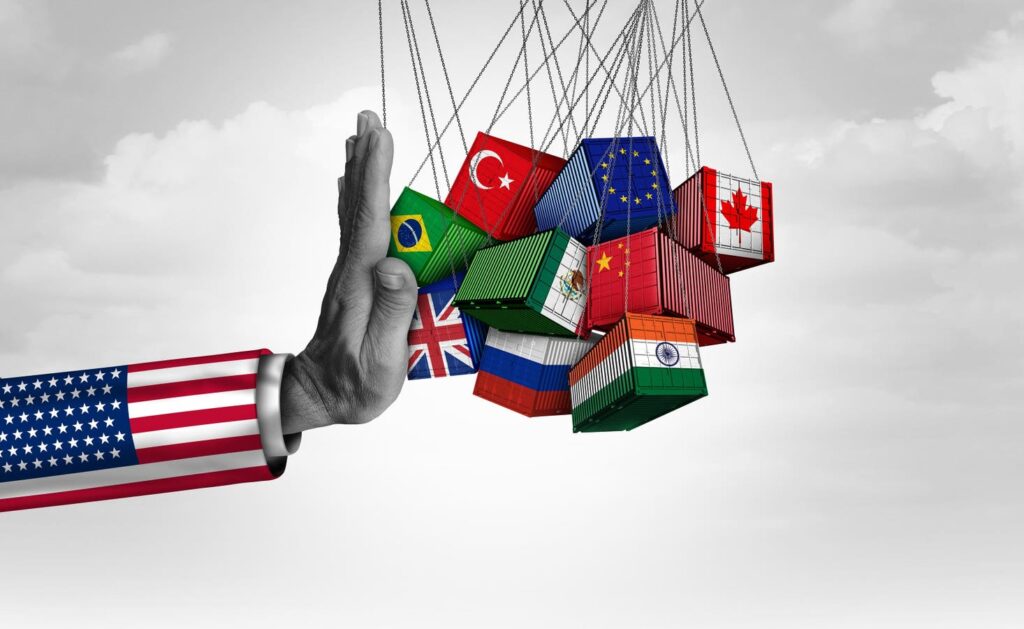The Market’s Wild Ride
Over the last few trading days, the stock market has delivered a masterclass in volatility:
- April 2nd: President Trump announced a universal 10% tariff on imports and sweeping reciprocal tariffs. The S&P 500 dropped more than 12% over four trading days.
- April 9th: Trump declared a 90-day pause on most reciprocal tariffs (excluding China). The market rebounded an astonishing 9.5% in a single day—a one-day move roughly equivalent to the market’s average annual return of about 10%.
- April 10th: Investors again panicked, sending the market down over 5% intraday, ultimately closing down 3.5%.
If you’re feeling whiplashed, you’re not alone. Unfortunately, this dramatic movement—up and down—isn’t an error in the system. It is the system itself at work.
Extreme Bouts of Volatility are a Normal Feature of the Stock Market
The S&P 500’s average daily move is just 0.75%. Most of the time, the market drifts calmly within a relatively tight range, and gains and losses are rarely more than one percent on any given day.
Then, without warning, volatility spikes, and markets swing wildly—often in rapid succession.
The chart above, showing daily S&P 500 returns since 1978, illustrates this vividly: long stretches of relative quiet punctuated by bursts of intense volatility. This pattern isn’t accidental—it’s built into the market’s DNA.
Market volatility isn’t a bug. It’s a feature.
Beyond Statistical Probability
The 9.5% gain on April 9th wasn’t just large; it was statistically absurd—a move greater than eight standard deviations from the average. According to bell-curve math, an event this extreme should happen:
- Once every 750 trillion trading days
- Or roughly once every three trillion years
Yet since 1978, we’ve experienced 11 such eight-plus standard deviation days.
Similarly, the nearly 5% and 6% market drops on April 3rd and 4th were four- and five-standard-deviation events, which theoretically should occur only:
- Every 264 years (for the 5% drop)
- Every 45,000 years (for the 6% drop)
But the market has experienced 48 of these “impossible” days since 1978.
Clearly, real markets don’t obey the tidy bell-curve models taught in finance textbooks.
Volatility Comes in Waves
Market volatility doesn’t follow a neat pattern. It’s rarely just fear followed by calm. Instead, it often oscillates between:
- Fear
- Hope
- Euphoria
- Then fear again (or even panic)
… as investors struggle to price uncertainty.
Look at the recent sequence again:
- Down 12.6% over four days
- Up 9.52% in one day
- Down another 3.5% the very next day
This sort of volatility is typical when markets confront radical uncertainty like the trade war has introduced.
What Investors Should Do Now
We’re currently in the thick of volatility—the storm is here. Now isn’t the time to build resilience from scratch; it’s time to practice good investor behavior. Here’s what you should do right now:
1. Embrace Volatility, but Maintain Perspective
We can’t predict the future, but we can certainly learn from the past. Every significant volatility spike—the Global Financial Crisis, the Dotcom bust, the COVID crash—felt terrifying at the time. Yet, portfolios diversified across bonds, and different classes of stocks came out okay. Investors who stayed calm and stayed invested enjoyed strong future returns. Check out the chart below, which highlights notable adverse events. From our perch in the future, the stock market turmoil these events caused now look like minor blips.
Of course, each of the above crises was different than the current trade war. But every time is different. We hadn’t had a financial crisis since the Great Depression until 2007 brought us the Great Financial Crisis. We hadn’t had a global pandemic since the Spanish Flu of 1918 until COVID came calling in 2020. And so on . . . . But the pattern has remained the same – the stock market recovers.
2. Stop Looking at Your Portfolio (Seriously!)
Obsessively checking your portfolio during volatility won’t help. In fact, it’s quite the opposite. Constantly tracking daily swings magnifies anxiety, making disciplined decisions harder. The best investors remain calm by tuning out short-term noise and focusing on their long-term goals. Trust your portfolio to do its job over time.
3. Stay Invested—Especially Now
No one, not even “experts,” can reliably predict what happens next. This is especially true now, given that a single person, President Trump, has the power to chart the course of the trade war and economy, and nobody knows what he will do next.
Jumping out of the market risks missing the rebound—which historically arrives swiftly and unexpectedly. Missing that rally is far more damaging than enduring temporary volatility. Once you leave, it’s psychologically harder to re-enter. Stay the course.
A Final Thought
The most significant rewards in investing don’t go to those who try to predict volatility—they go to those who patiently endure it. Keep calm, stay invested, and trust that your patience will ultimately be rewarded.
And remember that you’re not alone if you struggle to maintain perspective and navigate this uncertainty. My book, The Uncertainty Solution: How to Invest with Confidence in the Face of the Unknown, tackles precisely these challenges—helping you understand volatility, manage uncertainty, and how to behave so that you and your portfolio thrive through turbulent times.
Read the full article here

